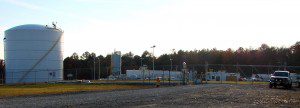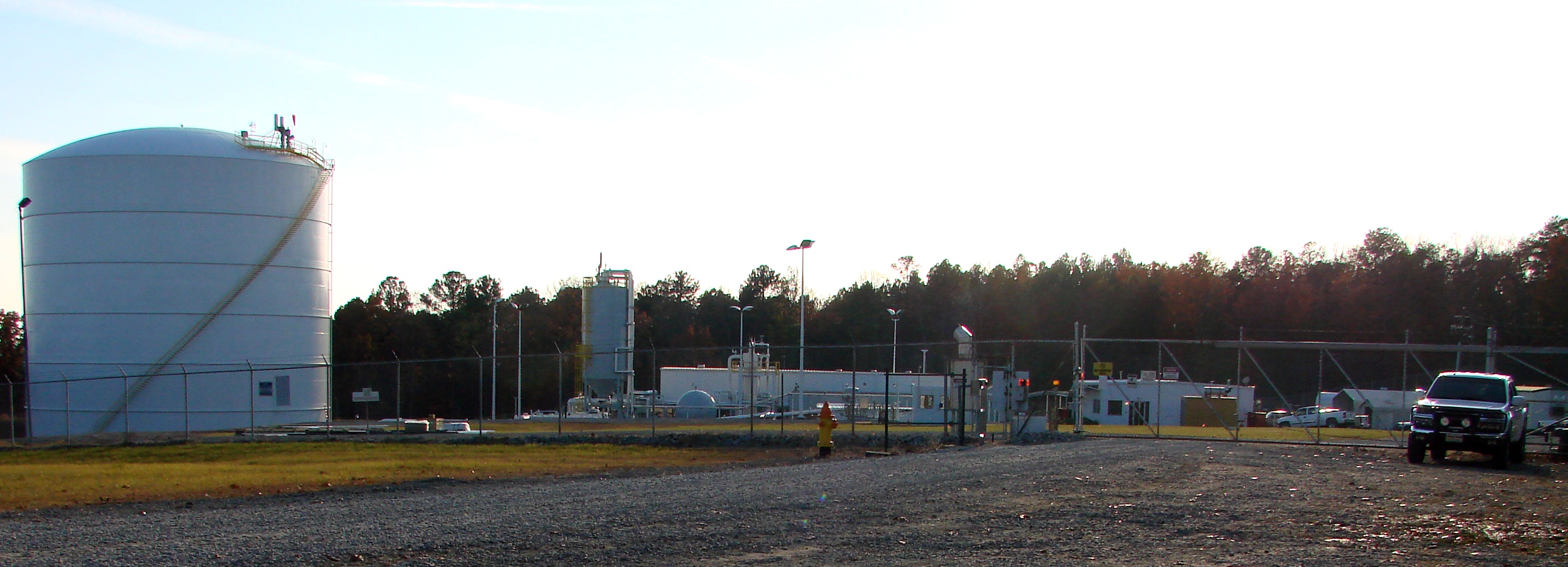By Tina Tidmore
Trussville Utilities, along with the city of Trussville, are taking the lead in commercial use of compressed natural gas. At the same time, Trussville Utilities is leaving behind the manufacturing of liquefied natural gas.

Hidden off of Floyd Bradford Road, the liquefied natural gas plant is putting Trussville on the national map in the emerging market of LNG for large diesel engines. Photo by Tina Tidmore/Trussville Tribune
Pivotal, a subsidiary of AGL Resources Inc., purchased the southeast Trussville LNG plant one year ago. After about $10 million in facility upgrades, the company started plant operation in mid-November, said David Schultz, AGL’s vice president of fuels
.
The annual cost to Trussville Utilities was $750,000 just for maintenance and insurance, said Trussville Utilities Manager Michael Strength.
“The facility was not inexpensive to operate due to the nature of cryogenic equipment,” he said.
This was necessary because the LNG stored in the facility’s tank had to be kept at about minus 260 degrees. Yet, Trussville Utilities rarely needed the LNG stored at the 1970s facility that is located off of Floyd Bradford Road.
“The facility was used only three or four occasions in the last 10 years,” Strength said.
Forty years ago, Trussville Utilities operated the plant to create and store the LNG, which takes up one-six hundredth of the space than the gaseous form. At that time, Trussville Utilities’ portion of gas coming from the interstate pipeline in the area was limited, and the prices were much higher in the winter. Thus, taking that low-priced gas in the summer and storing it in a liquefied form provided for a continuous supply to their customers at a reasonable rate in the winter.
Industry changes made them draw on that stored gas less and less.
“Since its construction, the pipeline constraints have lessened, and Trussville now has more pipeline capacity on winter days, eliminating the need for the facility to serve Trussville customers,” Strength said. “Additionally, market conditions have changed due to use of natural gas to generate electricity, so the seasonal swings in natural gas prices have been minimized.”
Selling the facility not only reduces the drain on Trussville Utilities resources from storing the rarely used LNG, but it also brought in an undisclosed amount in the plant’s purchase price.
Emerging Demand for LNG
According to the AGL website, the Trussville facility is the company’s first LNG facility dedicated solely to the merchant market. Their press release says the facility can produce 60,000 gallons of LNG per day.
“Natural gas, when cooled to the point of becoming a liquid is much easier to transport for use where piped natural gas is impractical or unavailable,” said the AGL press release announcing the plant purchase.
The LNG produced at the Trussville facility is transported by truck and marketed as substitute fuel for l8-wheeler trucks, train locomotives and other diesel engines in what AGL’s Schultz said is an emerging market.
“It’s cleaner, cheaper and safer,” Schultz said. He said another attractive feature is that the LNG from the Trussville plant is an American product.
These large, heavy-duty engines will need to be converted to using LNG. A thermos keeps the fuel cool for about a week, which means it is more useful for engines that run regularly. And the liquefied gas must be re-vaporized in the engine, said Schultz.
To make practical for 18-wheeler trucks, “a whole network and infrastructure must be built,” Schultz said. This is beginning to happen with Birmingham Flying J on Daniel Payne Drive in Birmingham listed on Clean Energy’s website as a future LNG truck fueling station.








